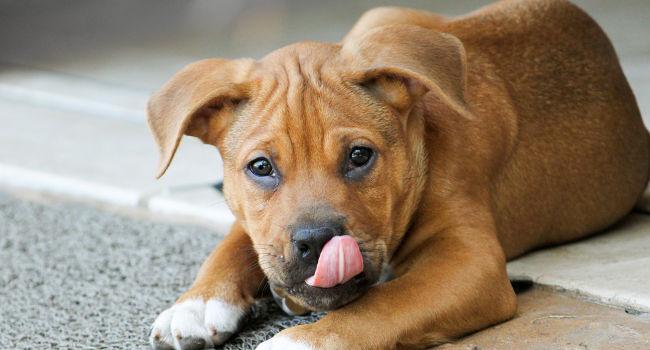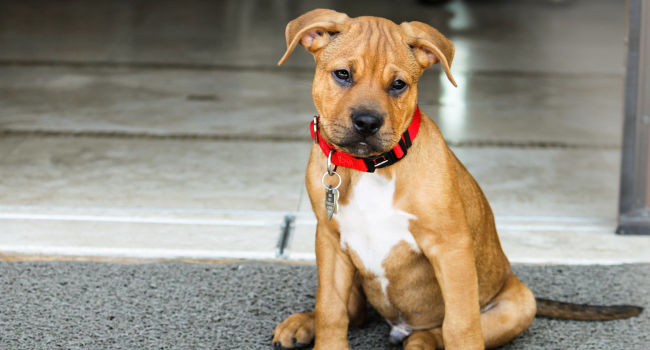Pitbull Boxer Mix: What to Expect From The Bullboxer Pit

Crossbreeding dogs has been around for decades because people try to breed for the best traits in both parent dogs in a single dog. This is where the Pitbull Boxer mix comes in, but it’s important to understand that most of these puppies aren’t first-generation and you can have more of one parent’s traits than the other breed.
However, you’ll typically end up with a loving, loyal, and intelligent family dog that is great around kids, teenagers, other pets, and adults. This guide will cover everything you need to know about this designer dog including their history, temperament, medical issues, grooming, tips, and more.
Origin of the Pitbull Boxer Mix
The American Pitbull Terrier has a long history that started in 19th century England by crossing an Old English Bulldog with an Old English Terrier to create an agile, strong, and athletic dog that was perfectly suited for pit fighting. They made their way to the United States and were turned into excellent family pets with the right training and socialization.
The Boxer has a history that goes back centuries as one of the most popular war dogs that can trace their origins to Germany and England. They’re one of the most popular family dogs today by AKC standards, and they’re well known for their laid back and lovable personalities.
When people breed these dogs, they want to get the agility and athleticism of the Pitbull along with the strong and lovable personality of the Boxer. Both breeds have guarding instincts and strong personalities, and you can almost guarantee that your puppy will show these traits whether they’re first-generation or not.
Other Popular Names for the Pitbull Boxer Mix
Along with the more obvious name for this mixed breed, both owners and breeders call them different names. These names include but are not limited to:
- American Bullboxer
- Bullboxers
- Boxer-Pitbull Mix
- Pitbull Boxer Mix
- Pitoxer
- The Bullboxer Pit
It’s also important to note that there are four dog breeding organizations that officially recognize this type of mixed breed. This is huge because most dogs don’t get this recognition, and the organizations are:
- American Canine Hybrid Club
- Designer Breed Registry
- Designer Dogs Kennel Club
- International Designer Canine Registry (IDCR)
Bullboxer Pit Temperament
Generally speaking, both dogs have independent streaks and strong personalities, but they’re also very family-oriented and loyal to their owners. Each puppy is different, and you do want to keep an eye out for possible aggressive traits, but you can curb these traits by starting socialization and training as soon as you bring them home.
Also, it’s important to note that Boxers usually don’t get along with other dog breeds of the same sex, but you can potentially get around this if you already have a dog and you’re adding one of these puppies to your family. Both breeds are also great watchdogs, and it’s important to train them and show them the boundaries between what is acceptable and what isn’t when it comes to new people coming into the home.
These dogs are higher energy and very smart, and they may be too rambunctious for older dogs or younger children because they could accidentally knock them down or hurt them when they’re trying to play. You should be prepared for a loving, loyal, and energetic dog when you bring your puppy home.
Size, Height, and Weight of the Boxer Pitbull Mix
Both parent dogs are medium to large breeds, and an adult mix of the two stands between 17 and 25-inches at the shoulder. They can weight between 40 to 80 pounds with the females being the shorter and lighter of the sexes, but most Bullboxers tend to fall in the mid-range for size and weight.
Again, this varies from puppy to puppy depending on which parent’s traits are dominant and which parent your puppy takes after more. You could end up with a larger adult dog or a more compact dog that takes after the Pitbull half of the genes.
Related: Best Dog Food for Pitbull Mixes
Grooming Requirements and Coat Colors of the Bullboxer Pit
These dogs are relatively easy to groom because they have short coats that lack the double layer that you’ll find on Rottweilers or other breeds. This means that they don’t usually shed much, and you can get by with brushing them out or wiping them down with a damp cloth once a week to get rid of any knots or debris.
You do want to be careful of significant temperature fluctuations with this dog because their coat isn’t thick enough to protect them from extreme hot or extreme cold, and you should avoid leaving them outside if the temperature gets above 86 degrees or below freezing (32 degrees). Winter coats or cooling vests are great for this breed depending on the season. They come in a variety of colors including black, blue, tan, brindle, red, white, fawn, grey, and tan.
This dog has a powerful body with a short head and a large, broad muzzle that takes after the Pitbull and other Bully breeds. You’ll most likely get a dog with long legs, strong hindquarters, and a deep chest that goes to a trim waist with good muscle definition.
Pitbull Boxer Mix Exercise Requirements
Both parent breeds of dogs are athletic dogs that are highly intelligent, and this means that you’ll want to plan for at least an hour of exercise each day along with mental stimulation to keep them from engaging in destructive behaviors like chewing. They like to run, and they’re the perfect companion dogs to take on a short jog or a run.
It’s also important that this dog has plenty of toys around that challenge them and that are durable because this dog’s powerful jaws can chew through most toys very quickly. This is also an opportunity for you to bond with your puppy and establish a routine, and you can also slip some training time in to engage them.
Training and Socializing Your Dog
As we mentioned earlier, training and socializing your dog from the start are the keys to ending up with an obedient, loving, and confident dog that can handle a variety of social situations with other people and animals. These dogs are stubborn, so training them may take several repeated attempts before they start to understand what you want them to do and not do.
When it comes to socializing your dog, you want to start as early as the first week you bring them home and make it a goal to have new people or animals over to your home at least two or three times each week. You also want to take your puppy out to areas that you’ll frequent as they get older and introduce them to new dogs and people with positive reinforcement and consistency.
If you’re not sure how to go about training or socializing your new puppy, it’s best to enlist the help of a certified dog trainer because they’ll help teach you techniques that you can use on your own while training your dog at the same time. These classes give you another chance to bond with your dog.
Common Medical Issues to Watch For

As long as you exercise your dog and keep them at a healthy weight, they can easily live up to 14 years and beyond as a happy and healthy dog. However, there are a few medical issues that are prominent with this mixed breed, and they are:
Allergies
Pitbulls are prone to developing skin allergies that vary from year-round issues too hot spots, and your mixed breed dog is also prone to having them. Food allergies are also common with this type of dog, particularly to certain gains or protein sources like chicken or chicken by-products.
Your veterinarian can help to diagnose your dog’s allergies and help you plan out a treatment plan. This could entail removing whatever they’re allergic to if it’s a food allergy to giving your dog antihistamines or even having them come in every month or two for allergy shots to reduce their symptoms.
Cancer
The majority of both Boxers and Pitbulls are healthy, there is a slightly increased chance that your mixed breed could develop a rather aggressive form of blood vessel cancer called hemangiosarcoma. Unlike other forms of cancer, this type can be more difficult to diagnose properly, and it is also more aggressive, so this means that it can spread quickly.
To avoid this, you want to get in touch with your veterinarian as soon as you notice changes with your dog including weight loss, weakness, distended abdomen, and trouble breathing. Once your vet gives you a diagnosis, they can start giving you possible treatment options.
Canine Parvovirus
Pitbulls, in particular, are susceptible to catching Parvo or Canine Parvovirus, and this is a highly contagious disease that can quickly spread from dog to dog. There are two different forms of this virus, and it attacks your dog’s digestive tract or their cardiovascular system.
Unfortunately, there is no real cure for Parvo because it’s a viral infection, but you can successfully manage the symptoms and work with your veterinarian to prevent secondary infections. Your dog will go on a regime of IV fluids to help prevent dehydration, a highly nutritional dog food, and you’ll have to disinfect your dog’s space and quarantine your dog from other animals for weeks.
Glaucoma
You may also notice that your dog has problems with their eyes, and they’re particularly prone to developing glaucoma as they start to get older. Glaucoma is a medical condition where pressure builds up inside of your dog’s eye, and this pressure can eventually damage your dog’s optic nerve.
Most cases of Glaucoma go undetected until your dog’s vision is permanently damaged, but you can manage it with medications and a minimally invasive draining of your dog’s eye. The good news is that most dogs adapt very well to losing sight in one eye with very few difficulties.
Heart Disease
Heart disease is common with these dogs, particularly a form of heart disease called aortic stenosis. Aortic stenosis is a serious condition where there is a narrowing in the aorta of the heart or the vessel that is responsible for carrying the blood away from your dog’s heart.
This results in added pressure on your dog’s heart and lungs, and they can start having difficulty breathing, weight loss, and it can eventually lead to congestive heart failure. Your vet can treat this medical condition with medications to manage it, surgery with a balloon placement, or open heart surgery.
Hip Dysplasia
These are heavier and more compact dogs, and this can put a lot of additional stress on their ball and socket joints like their hips. Hip dysplasia is a common medical condition where there is a malformation in your dog’s ball and socket joint that makes its grind together instead of sliding smoothly.
When this happens, your dog can get stiff and experience pain when they lay down or try to get up, run, walk, or go upstairs. You can give your dog joint supplements, pain medications and anti-inflammatories to help manage the pain and swelling, but surgery is the best treatment option available to shave down the bone, so it slides smoothly along.
Obesity
These dogs love to eat, and they can put on weight quickly if they’re not as active or they’re eating too much of a higher calorie food. Unfortunately, it can be far more difficult to remove the weight once your dog puts it on, and this can lead to a variety of health issues.
Obesity puts your dog at a higher risk for problems with the heart, and it also puts a lot of additional stress on their joints and skeletal system as a whole. This can lead to things like joint deterioration, fatty tumors, high cholesterol, and issues with their muscles.
Tips for Owning Bullboxers
- You can expect to pay between $200 to $500 for this dog.
- Make sure that you have durable toys on hand for this dog to chew on because they have powerful jaws.
- Plan to spend a lot of time with this dog and don’t leave it alone for extended periods of time.
- They don’t get along well with dogs of the same sex, and they may be too playful for older dogs to handle.
- These dogs need daily exercise in short bursts with 10 to 15-minute breaks between sessions.
- You’ll have to reign in your dog’s protective instincts and give them consistent training.
Bottom Line
The Pitbull Boxer mix is a loyal and friendly dog that is excellent around families and kids. They do require firm and consistent training, but you’ll get a friendly and protective dog that will be able to keep you safe and be a faithful companion throughout their lives.
